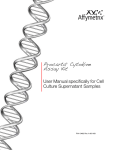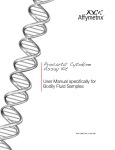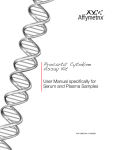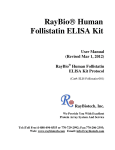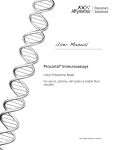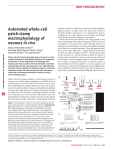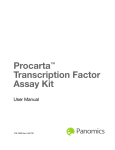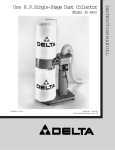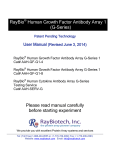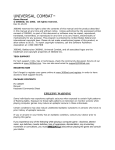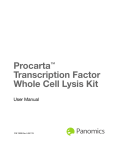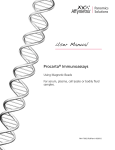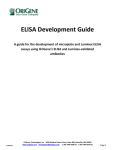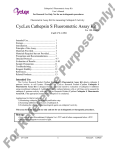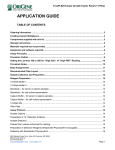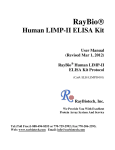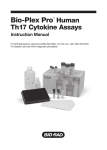Download Procarta®Cytokine Assay Kit
Transcript
Procarta®Cytokine Assay Kit User Manual Specifically for measuring Cytokines in Tissue or Cell Lysates Panomics I Affymetrix, Inc. Procarta Cytokine Assay Kit User Manual Copyright © Copyright 2009, Affymetrix, Inc. All rights reserved. Trademarks Procarta is a registered trademark of Affymetrix, Inc. xMAP and Luminex are registered trademarks of the Luminex Corporation. Bio-Plex is a registered trademark of Bio-Rad Laboratories. Citing Procarta in Publications When describing a procedure for publication using this product, we would appreciate it if you would refer to it as the Procarta® Cytokine Assay Kit. If a paper cites a Procarta product and is published in a research journal, the lead author(s) may receive a travel stipend for use at a technology conference or tradeshow by sending a copy of the paper to our technical support group at [email protected] or via fax at (510) 818-2610. Disclaimer Affymetrix, Inc. reserves the right to change its products and services at any time to incorporate technological developments. This manual is subject to change without notice. Although this manual has been prepared with every precaution to ensure accuracy, Affymetrix,Inc. assumes no liability for any errors or omissions, nor for any damages resulting from the application or use of this information. Contents About the User Manual . . . . . . . . . . . . . . . . . . . . . . . . . . . . . . . . . . . . . . . . . . . . . . . . . 5 Who Should Read this Manual. . . . . . . . . . . . . . . . . . . . . . . . . . . . . . . . . . . . . . . 5 What this Manual Covers . . . . . . . . . . . . . . . . . . . . . . . . . . . . . . . . . . . . . . . . . . . 5 Safety Warnings and Precautions . . . . . . . . . . . . . . . . . . . . . . . . . . . . . . . . . . . . 5 For More Information . . . . . . . . . . . . . . . . . . . . . . . . . . . . . . . . . . . . . . . . . . . . . . 5 About the Procarta Cytokine Assay Kit . . . . . . . . . . . . . . . . . . . . . . . . . . . . . . . . . . . . . 6 Procarta Cytokine Assay Defined. . . . . . . . . . . . . . . . . . . . . . . . . . . . . . . . . . . . . 6 Available Kit Formats . . . . . . . . . . . . . . . . . . . . . . . . . . . . . . . . . . . . . . . . . . . . . . 6 Procarta Cytokine Assay Kit Contents and Handling Conditions . . . . . . . . . . . . . . . . . . 6 Kit Contents and Storage . . . . . . . . . . . . . . . . . . . . . . . . . . . . . . . . . . . . . . . . . . . 6 Kit Handling . . . . . . . . . . . . . . . . . . . . . . . . . . . . . . . . . . . . . . . . . . . . . . . . . . . . . 6 Required Materials and Equipment Not Provided . . . . . . . . . . . . . . . . . . . . . . . . . . . . . 7 Equipment . . . . . . . . . . . . . . . . . . . . . . . . . . . . . . . . . . . . . . . . . . . . . . . . . . . . . . 7 Sample Type Specific Materials . . . . . . . . . . . . . . . . . . . . . . . . . . . . . . . . . . . . . . 7 Overview of Assay Workflow . . . . . . . . . . . . . . . . . . . . . . . . . . . . . . . . . . . . . . . . . . . . . 7 Set-Up and Operation of the Vacuum Manifold System . . . . . . . . . . . . . . . . . . . . . . . . 8 About Using the Vacuum Manifold . . . . . . . . . . . . . . . . . . . . . . . . . . . . . . . . . . . . 8 Sealing Filter Plates . . . . . . . . . . . . . . . . . . . . . . . . . . . . . . . . . . . . . . . . . . . . . . . 8 Setting Up and Calibrating the Manifold. . . . . . . . . . . . . . . . . . . . . . . . . . . . . . . . 8 Operating the Manifold . . . . . . . . . . . . . . . . . . . . . . . . . . . . . . . . . . . . . . . . . . . . . 9 Assay Preparation . . . . . . . . . . . . . . . . . . . . . . . . . . . . . . . . . . . . . . . . . . . . . . . . . . . . 10 About Preparing Samples . . . . . . . . . . . . . . . . . . . . . . . . . . . . . . . . . . . . . . . . . 10 Preparing Brain Tissue Lysates . . . . . . . . . . . . . . . . . . . . . . . . . . . . . . . . . . . . . 10 Preparing Lysates from Cultured Cells. . . . . . . . . . . . . . . . . . . . . . . . . . . . . . . . 10 Preparing Standards. . . . . . . . . . . . . . . . . . . . . . . . . . . . . . . . . . . . . . . . . . . . . . .11 Preparing 1X Wash Buffer . . . . . . . . . . . . . . . . . . . . . . . . . . . . . . . . . . . . . . . . . .11 Assay Procedure . . . . . . . . . . . . . . . . . . . . . . . . . . . . . . . . . . . . . . . . . . . . . . . . . . . . . 12 Assay Guidelines . . . . . . . . . . . . . . . . . . . . . . . . . . . . . . . . . . . . . . . . . . . . . . . . 12 Before You Start . . . . . . . . . . . . . . . . . . . . . . . . . . . . . . . . . . . . . . . . . . . . . . . . . 12 Performing the Assay . . . . . . . . . . . . . . . . . . . . . . . . . . . . . . . . . . . . . . . . . . . . . 12 Troubleshooting . . . . . . . . . . . . . . . . . . . . . . . . . . . . . . . . . . . . . . . . . . . . . . . . . . . . . . 16 Possible Problems and Recommended Solutions . . . . . . . . . . . . . . . . . . . . . . . 16 Contacting Panomics . . . . . . . . . . . . . . . . . . . . . . . . . . . . . . . . . . . . . . . . . . . . . . . . . . 17 Technical Help . . . . . . . . . . . . . . . . . . . . . . . . . . . . . . . . . . . . . . . . . . . . . . . . . . 17 For Additional Services . . . . . . . . . . . . . . . . . . . . . . . . . . . . . . . . . . . . . . . . . . . 17 Appendix I . . . . . . . . . . . . . . . . . . . . . . . . . . . . . . . . . . . . . . . . . . . . . . . . . . . . . . . . . . 18 Bead-Analyte Associations . . . . . . . . . . . . . . . . . . . . . . . . . . . . . . . . . . . . . . . . 18 Assay Performance . . . . . . . . . . . . . . . . . . . . . . . . . . . . . . . . . . . . . . . . . . . . . . . . . . . 19 Standards Comparison. . . . . . . . . . . . . . . . . . . . . . . . . . . . . . . . . . . . . . . . . . . . 19 Limit of Detection . . . . . . . . . . . . . . . . . . . . . . . . . . . . . . . . . . . . . . . . . . . . . . . . 19 Procarta Cytokine Assay User Manual iii Assay Cross Reactivity and Specificity . . . . . . . . . . . . . . . . . . . . . . . . . . . . . . . . 19 Assay Precision . . . . . . . . . . . . . . . . . . . . . . . . . . . . . . . . . . . . . . . . . . . . . . . . . 20 Assay Accuracy . . . . . . . . . . . . . . . . . . . . . . . . . . . . . . . . . . . . . . . . . . . . . . . . . 20 Sample and Blank Plate Layouts . . . . . . . . . . . . . . . . . . . . . . . . . . . . . . . . . . . . 21 About the User Manual About the User Manual Who Should Read Anyone that has purchased a Procarta Cytokine Assay Kit from Panomics to perform this Manual quantitative, multiplexed measurement of Human, Mouse or Rat cytokines derived from Tissue or Cell Lysates using the Luminex® Technology. IMPORTANT Please note that we provide application specific manuals for cytokine measurement from Cell Culture Supernatants and Serum/Plasma Samples. Our most updated manuals can be obtained from our website. ] What this Manual This manual provides recommendations and step-by-step procedures for the Covers following: ♦ Sample and assay preparation ♦ Set up and operation of the vacuum manifold system ♦ Assay procedure ♦ Troubleshooting Safety Warnings ! WARNING ! Though the general procedure is very similar to other and Precautions Luminex cytokine assays, there are subtle differences due to the approach we have taken in developing the assay to have an improved workflow, so please ensure that you do not refer to other vendors manuals and please read the supplied Panomics manual prior to starting the assay. CAUTION All chemicals should be considered potentially hazardous. We recommend that this product and its components be handled by those trained in laboratory techniques and be used according to the principles of good laboratory practice. CAUTION This kit contains small quantities of sodium azide. Sodium azide reacts with lead and copper plumbing to form explosive metal azides. When disposing, flush drains with a large volume of water to prevent azide accumulation. Observe all state and local regulations for disposal. For More For information about the Procarta products mentioned in this manual, visit our Information website at www.panomics.com. Procarta Cytokine Assay User Manual Page 5 About the Procarta Cytokine Assay Kit About the Procarta Cytokine Assay Kit Procarta Cytokine The Procarta Cytokine assays are multiplex immunoassays based on xMAP® Assay Defined detection technology developed by Luminex. This bead based multiplex assay kit can quantitatively measure multiple cytokines from as little as 25 µL of Tissue or Cell Lysate in 3 hours with a sensitivity of less than 1 pg/ml/cytokine. For increased sensitivity, the sample input can be increased to 100 µL of Tissue or Cell Lysate. Available Kit The cytokine panels for Procarta Cytokine Assay Kit are available as: Formats ♦ Standard pre-mixed panels ♦ “By Request”, user selected panels, provided in premixed and ready to use format Procarta Cytokine Assay Kits are available as single or ten plate 96-well formats and contain all the reagents required to detect cytokines from cell culture supernatants. For detection of cytokines in plasma or serum, standard diluent kits are sold separately. Procarta Cytokine Assay Kit Contents and Handling Conditions Kit Contents and The Procarta Cytokine Assay Kit contains the following components. The kits are Storage available as single plate or ten plate formats. Refer to the product insert for quantities and details of components supplied. Procarta Cytokine Kit components: Component Kit Handling ♦ Page 6 Storage Reading Buffer 4 °C 10X Wash Buffer 4 °C Detection Antibody, premixed 4 °C Antigen Standards, premixed, lyophilized 4 °C Streptavidin-PE (SAPE) 4 °C Antibody Beads 4 °C Filter Plate 4 °C Plate Seals 4 °C PCR 8 tube strip 4 °C Store the entire kit at 4 °C ♦ Do not reuse or store resuspended antigen standards ♦ 10X Wash Buffer and its 1X dilution can be stored at 4 °C or room temperature for up to 6 months Procarta Cytokine Assay User Manual Required Materials and Equipment Not Provided Required Materials and Equipment Not Provided Equipment Item Source Vacuum filtration system Millipore (P/N MAVM0960R and WP6111560) Microplate shaker Labline model 4625 or equivalent with 3 mm orbit Luminex or Luminex-based instrument MiraiBio, Bio-Rad or other Luminex instrument provider Sample Type When preparing Tissue Lysates for cytokine measurements, you will need to order Specific Materials the Procarta Lysis Buffer. Catalog Number PC6002 Contents Procarta Lysis Buffer Size 20 mL Overview of Assay Workflow Step 1. Prepare Samples and Reagents a. Collect and prepare samples b. Prepare antigen standards c. Prepare 1X Wash Buffer Step 2. Pre-wet Filter Plate a. Let sit for 5 min b. Filter Step 3. Add Antibody Beads a. Filter b. Wash once c. Filter Step 4. Add samples/standards a. Incubate 30 min shaking, 20-25 C b. Wash/filter three times Step 5. Add Detection Antibody a. Incubate 30 min shaking, 20-25 C b. Wash/filter three times Step 6. Add Streptavidin-PE a. Incubate 30 min shaking, 20-25 C b. Wash/filter three times Step 7. Procarta Cytokine Assay User Manual Read plate Page 7 Set-Up and Operation of the Vacuum Manifold System Set-Up and Operation of the Vacuum Manifold System About Using the This topic describes how to set up and use the Millipore vacuum manifold. This Vacuum Manifold includes how to calibrate the pressure and important guidelines that will help to ensure good assay reproducibility. We recommend that you set up and calibrate the manifold before you start the assay to ensure the assay is performed without interruption. Sealing Filter ♦ Plates Lay a Plate Seal over the Filter Plate and roll a 5 mL serological pipet (or equivalent) over the Plate Seal to seal the Filter Plate. This ensures adequate plate sealing while avoiding any leakage due to capillary action. IMPORTANT To avoid Filter Plate leakages, do not seal Filter Plates using a rubber roller (or equivalent) as they apply significant pressure resulting in leakage. ♦ Seal all unused wells with an enclosed Plate Seal to ensure proper vacuum pressure. Setting Up and To set up and calibrate the manifold: Calibrating the Step Action Manifold 1 Set up the Filter Plate vacuum manifold as shown below. Follow the manufacturer’s manual for details. 2 Calibrate the vacuum pressure using the Filter Plate: a. Place the Filter Plate on top of the manifold. b. Turn on the vacuum. c. Press the corners of the Filter Plate to form a tight seal. d. Set the pressure to 2–3 mm of Hg. IMPORTANT If the vacuum is too high, beads will be trapped on the filter. Page 8 Procarta Cytokine Assay User Manual Set-Up and Operation of the Vacuum Manifold System Operating the To operate the manifold: Manifold Step 1 Action Once the vacuum is set correctly, remove the Filter Plate. Check vacuum calibration periodically. As a general guideline, 200 μL of solution should take approximately 8-10 seconds to clear the well of a Filter Plate. 2 For all filtration steps, turn the Filter Plate vacuum manifold on, transfer the Filter Plate to the vacuum manifold and then filter the solution. Avoid splashing and cross-contamination of wells during all wash steps. IMPORTANT During filtration, maintain the vacuum between 2–3 mm of Hg. Higher vacuum settings may result in Capture Bead loss. IMPORTANT Do not allow the Filter Plates to air-dry following washes. Immediately add the next component following each filtration step. IMPORTANT We recommend peforming all of the washes steps next to the manifold to minimize the amount of time that the beads are exposed to air. 3 Break the vacuum immediately after each solution has been completely filtered from all wells (approximately 8-10 seconds). Note Wells typically filter at different rates. 4 Place the Filter Plate back on the Filter Plate . 5 Following the last wash in each series, blot the bottom of the Filter Plate thoroughly with a paper towel to remove traces of 1X Wash Buffer. Avoid touching the bottom of the Filter Plate with your fingers or to the bench during manipulations and immediately move to the next step to ensure that the beads are in the appropriate buffered solution. Procarta Cytokine Assay User Manual Page 9 Assay Preparation Assay Preparation About Preparing This instruction manual is specifically intended for the application of measuring Samples cytokines from Tissue or Cell Lysates. We provide application specific manuals for measuring cytokines from Serum, Plasma and Cell Cultured Supernatants. You can visit our website to download our latest manuals. Examples are provided below for measuring cytokines derived from brain and cultured cells. Other tissues can be used as a source of starting material, but these protocols have been provided as examples. For other tissue specific protocols, please call or email our technical support staff. Preparing Brain Brain Tissue Lysates Tissue Lysates Step Action 1 Animals are rapidly transcardially perfused with ice cold saline containing heparin to remove the blood. 2 The animal is then decapitated, the brain removed rapidly and 8mm carotid slices (or any size designed) cut and put into ice cold PBS 3 Regions of interest are excised from the slices. These tissue chunks are approx 2x2x8mm. The bigger of tissue size, the better, as long as same size for every sample, including treated and untreated. The size can go up to 10mg 4 The tissue chunks are immediately put into ice cold Procarta lysis buffer which contain protease inhibitors (150 μl per tissue chunk; we keep each chunk separate), and left on ice until all regions of interest are excised. 150 μL of Procarta Lysis Buffer can be used for up to 10 mg of tissue. 5 The tissue is then homogenized in a dounce homogenizer until there are no more tissue clumps (approx. 30- 40 strokes) 6 Centrifuge at 14,000 rpm (bench top centrifuge) for 10 minutes at 4° C. 7 The supernatant is transferred to a new tube and is ready for use. Store the samples at -80°C if they are to be used at a later date. Preparing Lysates Cell Culture Lysates from Cultured Step Action Cells 1 Adherent Cells Preparation is for 1x10^6 to 1x10^7 cells grown in a 10 cm plate. Trypinsinze the cells and remove the cells using a cell scraper. Transfer the cells to a 15 ml conical tube and centrifuge at 500 x g at 4° C for five minutes. Carefully aspirate the supernatant and re-suspend the cells in 5 mls of ice cold PBS. Repeat this step using 5 mls of ice cold PBS and centrifuge again at 500 x g at 4° C. Completely remove all of the PBS. Suspension Cells Preparation is for 1x10^6 to 1x10^7 cells grown in a flask. Transfer cells to a 15 ml conical tube and spin at 500 x g at 4° C for five minutes. Carefully aspirate the supernatant and re-suspend the cells in 5 mls of ice cold PBS and spin again at 500 x g at 4° C. Completely remove all of the PBS. Page 10 2 Add 200 μL of ice cold Procarta Cell Lysis Buffer, pipette up and down several times and then incubate on ice for 5 minutes. 3 Transfer entire contents to a 1.5 ml microcentrifuge tube Procarta Cytokine Assay User Manual Assay Preparation Cell Culture Lysates Step Action 4 Centrifuge at 14,000 rpm (bench top centrifuge) for 10 minutes at 4° C. 5 The supernatant is transferred to a new tube and is ready for use. Store the samples at -80°C if they are to be used at a later date. Preparing To prepare standards: Standards Step Action 1 Reconstitute the premixed lyophilized protein standard with 250 μL of Procarta Lysis Buffer 2 Vortex gently for 10 seconds and incubate on ice for 5 minutes. Transfer the entire contents to the first tube of the PCR 8-tube strip provided. 3 Prepare serial dilutions of the premixed standard as indicated below. a. Using the 8 tube strip provided, add the following b. Add 75 μL of Procarta Lysis Buffer to tubes 2-8. Follow the table below to create the dilutions. Use a P200 pipette to transfer and mix the 25 μL standard from tube to tube. c. Store tube strip on ice until ready to use. When transferring the standards to the to beads in the filter plate, we recommend using a multi-channel pipette. d. See Plate Map for example serial dilutions and blank Preparing 1X Wash Buffer Step Tube Number Procarta Lysis Buffer (μL) Antigen Standard (μL) Final Analyte Concentration in the Assay (pg/mL) 1 — 250 10,000 2 75 25 from Tube 1 2500 3 75 25 from Tube 2 625 4 75 25 from Tube 3 156 5 75 25 from Tube 4 39 6 75 25 from Tube 5 9.76 7 75 25 from Tube 6 2.4 8 75 25 from Tube 7 0.6 Blank 100 per well Procarta Lysis Buffer 0 Action 1 Vortex the 10X Wash Buffer to dissolve all the salts. 2 Mix 20 mL of the 10X Wash Buffer with 180 mL deionized, sterile water. Note 1X Wash Buffer can be stored at 4 °C or room temperature for up to 6 months. Procarta Cytokine Assay User Manual Page 11 Assay Procedure Assay Procedure Assay Guidelines IMPORTANT For optimal assay performance and consistent results, please read these guidelines before proceeding with the assay. ♦ Change the pipet tips after every transfer and avoid creating bubbles when pipetting. ♦ Follow the guidelines in “Set-Up and Operation of the Vacuum Manifold System” on page 8. ♦ During the incubation steps, cover the Filter Plate assembly with aluminum foil to prevent photobleaching of the fluorescent beads. ♦ Bring all buffers to room temperature before setting up the assay. Store the detection antibody, antibody beads, Streptavidin-PE, and reconstituted standards on ice during the assay. Before You Start Make sure the Luminex or Luminex-based instrument is turned on at least 30 minutes before you intend to read your plates. Performing the To perform the assay: Assay Step 1 Action Columns 1 and 2 are typically used for duplicate standards. Mark the sample wells you want to use. A blank plate layout is provided in the appendix for recording your plate layout. 2 Seal the un-used wells of the plate with a Plate Seal provided in the kit before starting the assay. 3 Pre-wet the Filter Plate: a. Add 150 μL of Reading Buffer to each non-sealed well. b. Incubate 5 minutes at room temperature. c. Remove the Reading Buffer with vacuum filtration. Reading Buffer should clear wells within 3–5 seconds. If outside this range, see “Set-Up and Operation of the Vacuum Manifold System” on page 8. IMPORTANT Do not invert the plate. 4 Add the Antibody Beads: a. Vortex the premixed Antibody Beads for 30 seconds at room temperature. b. Add 50 μL of Antibody Beads to each unsealed well. c. Remove buffer with vacuum filtration. IMPORTANT Do not invert the plate. 5 Wash the Antibody Beads: a. Add 150 μL/well of 1X Wash Buffer and remove with vacuum filtration. IMPORTANT Do not invert the plate. b. Blot the bottom of the Filter Plate thoroughly with paper towels to remove residual buffer. 6 Page 12 Add 75 μL/well of Procarta Lysis Buffer to only the Standard Wells. Procarta Cytokine Assay User Manual Assay Procedure To perform the assay: (continued) Step Action 7 Add 25 μL/well of standards marked on the plate layout sheet. For the sample, add 100 μL/well of Lysate. For the blank samples, add 100 μL/well of Procarta Lysis Buffer. Seal the plate gently using the Plate Seal. If you are using 25 μL or 50 uL of Lysate, you will need to add 75 or 50 uL of Procarta Lysis Buffer for a total of 100 μL for each sample well. 8 Incubate and wash the Filter Plate: a. Completely wrap the Filter Plate with aluminum foil. b. Shake for 30 minutes at 500 rpm at room temperature. Optionally, you can incubate overnight without shaking at 4 °C, after the 30 minute shaking incubation step. c. Carefully remove the Plate Seal to avoid splashing the plate contents. d. Remove solution with vacuum filtration. IMPORTANT Do not invert the plate. e. When washing the plate, we recommend using multi-channel pipette and a large enough plastic reservoir for the wash buffer. We also recommend stationing the wash buffer reservoir next manifold to minimize the amount of time that the beads are exposed to air. f. 9 Wash the plate three times with 150 μL/well of 1X Wash Buffer. After the 3rd wash, blot the bottom of the Filter Plate with paper towels. Add premixed Detection Antibodies: a. Add 25 μL/well of the Detection Antibody. b. Seal the Filter Plate with a new Plate Seal. c. Completely wrap the Filter Plate with aluminum foil. d. Shake for 30 minutes at 500 rpm at room temperature. 10 Remove the solution with vacuum filtration and wash the plate: a. Carefully remove the Plate Seal to avoid splashing the plate contents. b. Remove solution with vacuum filtration. IMPORTANT Do not invert the plate. c. Wash the plate three times with 150 μL/well of 1X Wash Buffer. After the 3rd wash, blot the bottom of the Filter Plate with paper towels. 11 Add Streptavidin–PE: a. Vortex the Streptavidin–PE. b. Add 50 μL/well of Streptavidin-PE. c. Seal the Filter Plate with a new Plate Seal. d. Completely wrap the Filter Plate with aluminum foil. e. Shake for 30 minutes at 500 rpm at room temperature. 12 Remove the solution with vacuum filtration and wash the plate: a. Carefully remove the Plate Seal to avoid splashing the plate contents. b. Remove solution with vacuum filtration. IMPORTANT Do not invert the plate. c. Wash the plate three times with 150 μL/well of 1X Wash Buffer. After the 3rd wash, blot the bottom of the Filter Plate with paper towels. Procarta Cytokine Assay User Manual Page 13 Assay Procedure To perform the assay: (continued) Step 13 Action Prepare plate for analysis on a Luminex instrument: a. Add 120 μL/well of the Reading buffer. b. Seal the Filter Plate with a new Plate Seal. Note The Filter Plate can be wrapped with aluminum foil and stored for up to 48 hours before proceeding. However, delay in reading the plate may result in decreased sensitivity for some analytes. c. Shake for 5 minutes at 500 rpm at room temperature or until the Luminex instrument is available. d. Remove the Plate Seal before analyzing on the Luminex instrument. Page 14 Procarta Cytokine Assay User Manual Assay Procedure To perform the assay: (continued) Step 14 Action Analyze the plate following the respective operation manual for the Luminex or Luminex-based instrument. Software Sample Size DD Gate Timeout Bead Events/Be ad Region Luminex 100/ 50 μL 7,500-15,000 25 sec 50 or 100 50 μL 4335-10,000 45 sec 50 or 100 50 μL 2,000-15,000 25 sec 50 or 100 50 μL 4,335-10,000 25 sec 50 or 100 IS100 v 2.318 Bioplex/ Bio-Rad Miraibio/ Hitachi Starstation/ ACS When the Luminex beads are injected into the flow cell, a small percentage of the beads will have a tendency to clump and go through the flow cell as doublets. The DD Gate or Doublet Discriminator Gate will allow for discrimination of the doublets from the singlet beads. When setting the DD Gate, you can follow the appropriate settings from the table above. However, for the best results, you should adjust the DD Gate and center the gates around the largest peak which is the singlet beads. You can adjust the gates when processing the first sample. The Bio-Plex® Suspension Array System allows calibration using Low or High sensitivity settings. Perform the sensitivity selection during calibration, using predetermined values of CAL2 RP1 target, as provided by Bio-Rad. Using the RP1 Low target value will provide results comparable to those obtained from the Luminex 100. Using the RP1 High target value may increase detection sensitivity for low cytokine protein concentrations but sacrifices part of the linear dynamic range for high concentrations. We recommend RP1 Low target value for BioPlex. The number of beads events per region can be set to 50 or 100. Please note that the total time to measure 100 events vs 50 events will take longer. IMPORTANT Check to ensure the probe height in the Luminex instrument is adjusted appropriately for the Filter Plate. IMPORTANT We recommend that you calibrate the Luminex or Luminex-based instrument each day the assay is run. IMPORTANT If there is a malfunction of the machine or software during the run or there was a problem with the system, the plate can be re-processed on the Luminex machine. Remove the plate from the machine and vacuum filter the plate. Resuspend the beads in Reading Buffer and shake for 5 minutes then re-read. The plate may take longer to read since there will be less beads in the plate. Procarta Cytokine Assay User Manual Page 15 Troubleshooting Troubleshooting Possible Problems and Recommended Solutions Observation Possible Cause Recommended Action Filter plate leakage Vacuum pressure too high Adjust the vacuum pressure as recommended in “Set-Up and Operation of the Vacuum Manifold System” on page 8. Filter Plate is misaligned (at an angle) during incubation/processing Set the Filter Plate on a flat, level surface during incubation/processing. Leakage from capillary action After each vacuum step, blot the bottom of the Filter Plate using paper towels or absorbent paper. Plate Seal applied using too much force Lay Plate Seal on the plate and gently roll a 5 mL serological pipet over the plate to seal. Samples and antigen standards were not stored on ice Prepare the samples and standards on ice before setting up the assay. Bottom of the Filter Plate is not dry After each vacuum step, blot the bottom of the Filter Plate using paper towels or absorbent paper. Contamination from re-using the Plate Seal Use a new Plate Seal for each incubation step. The high concentration standards have high variability. After adding the standards and samples, it is very important that any excess standards are removed during the wash step Contamination from Wash Buffer Be careful not to splash Wash Buffer during wash steps into adjacent wells. The machine was calibrated using the high PMT (CAL2 High RP1) and the top 3 standards have similar MFI values Calibrate the machine using the CAl2 Low RP1 target value High CV Limited Dynamic Range when using the BioPlex software Page 16 Procarta Cytokine Assay User Manual Contacting Panomics Observation Possible Cause Recommended Action Low bead count Volume of bead solution is too low Add 120 μL/well Reading Buffer and shake for 5 minutes to resuspend beads before reading in the Luminex instrument. Beads are clumping Vortex the bead solution well before using in the assay. Vacuum pressure too high Use 2–3 mm Hg vacuum pressure. Filter ruptured due to excess vacuum time Do not use the vacuum over 10 seconds in any of the steps. Dyes contained in the beads are photo-bleached from overexposure to light Store bead solution and the assay plate in the dark Reader is clogged Follow the instructions in the Luminex instrument user documentation. Standards not reconstituted and diluted correctly Prepare fresh antigen standards following the instructions in “Preparing Standards” on page 11. Beads or reagents expired Verify the expiration date of the kit. Beads stuck to the bottom of the plate Make sure the plate is agitated at 500 rpm for the recommended time and for at least 5 minutes before reading. Reagents expired Verify the expiration date on the kit. Samples and antigen standards were not stored on ice Prepare the samples and standards on ice before setting up the assay. Low signal or sensitivity Poor recovery Contacting Panomics Technical Help For technical questions, contact our technical support group by telephone at 866-317-2626 or by email at [email protected], or visit our website www.panomics.com for an updated list of FAQs and product support literature. For Additional For information about Panomics products or for ordering information, contact your Services Regional Sales Manager, or visit our website at www.panomics.com. Procarta Cytokine Assay User Manual Page 17 Appendix Appendix Bead-Analyte Associations The following table may not be the most up to date current bead-analyte associations setting for your Luminex instrument. Please refer to your product insert for analytes included in your kit, especially if you have a custom order or “By Request” assay. Bead Human Bead Human Bead 24 Mouse Adiponectin Bead Rat 73 CRP 66 Adiponectin 22 IP10 54 CRP 74 I-TAC 8 CD120B 52 Eotaxin 84 EGF 6 Leptin 52 Eotaxin 46 G-CSF 17 ENA78 51 MCP - 1 46 G-CSF 36 GM-CSF 52 Eotaxin 13 MCP - 3 44 GM-CSF 21 ICAM 55 FGF - basic 80 MIF 43 IFM-gamma 43 IFN-gamma 46 G-CSF 11 MIG 18 IL - 1 alpha 18 IL-1 alpha 44 GM-CSF 8 MMP- 1 19 IL - 1 beta 19 IL-1 beta 61 GRO alpha 7 MMP- 2 20 IL - 2 20 IL-2 79 HGF 53 MMP- 3 21 IL - 3 34 IL-4 73 ICAM - 1 47 MIP - 1 beta 25 IL - 4 27 IL-5 48 IFN alpha 67 MIP - 3 alpha 26 IL - 5 25 IL-6 43 IFNy 12 MIP - 1 alpha 27 IL - 6 35 IL-10 62 IL - 1 alpha 83 MMP - 7 38 IL - 9 32 IL-12(p40) 18 IL - 1 beta 72 MMP - 8 28 IL - 10 44 IL-13 63 IL - 1ra 9 MMP - 9 33 IL - 12(p40) 28 IL-17 19 IL - 2 78 MMP - 12 34 IL - 12(p70) 57 IL-18 20 IL - 4 64 MMP - 13 36 IL - 13 37 KC 21 IL - 5 38 NGF 35 IL - 17 6 Leptin 25 IL - 6 14 PAI - 1 41 IL-23 54 MCP - 1 26 IL - 7 37 PDGFBB 22 IP10 51 MCP - 3 27 IL - 8 42 RANTES 37 KC 47 MIP-1 alpha 28 IL - 10 86 Resistin 6 Leptin 38 NGF 33 IL - 12(p40) 75 SAA 54 MCP - 1 42 RANTES 34 IL - 12(p70) 85 sCD40L 51 MCP - 3 29 TGF beta 35 IL - 13 77 sE-selectin 47 MIP - 1 alpha 33 TNF alpha 65 IL - 15 29 TGF beta 42 RANTES 26 V-CAM 36 IL - 17 45 TNF alpha 7 Srankl 56 VEGF 39 IL - 17F 32 TNF beta 29 TNF beta 57 IL-18 88 VCAM - 1 45 TNF alpha 41 IL-23 56 VEGF 56 VEGF *TGF-beta must be used as a single plex assay because the sample must be prepared in an acidic buffer. Page 18 Procarta Cytokine User Manual- Cell Culture Supernatants Assay Performance Assay Performance Standards The following table contains conversion factors for Procarta Antigen Standards for Comparison which World Health Organization (WHO) standards were available for comparison. Procarta Antigen Standards, Human Analyte WHO Lot Number 100 Procarta pg/mL = IL-1β 86/680 11.9 IU/mL IL-4 88/656 15.6 IU/mL IL-8 89/520 1.91 IU/mL IL-10 93/722 3.91 IU/mL IL-12(p70) 95/544 11.9 IU/mL IL-13 94/622 1.33 IU/mL IFNγ 88/606 29.4 IU/mL GM-CSF 88/646 20.3 IU/mL TNFα 88/786 147.7 IU/mL Procarta Antigen Standards, Mouse Analyte WHO Lot Number 100 Procarta pg/mL = IL-1α 93/672 580.8 IU/mL IL-1β 93/668 99.8 IU/mL IL-2 93/566 67.3 IU/mL IL-3 91/662 141.0 IU/mL IL-4 91/656 8.2 IU/mL IL-6 93/730 97.6 IU/mL GM-CSF 88/532 151.5 IU/mL TNFα 91/658 92.5 IU/mL Limit of Detection The Limit of Detection (LOD) for human, mouse and rat cytokines from cell culture supernatants, serum, and plasma samples is less than 1 pg/ml. The LOD is defined as the antigen concentration with a Median Fluorescent Intensity (MFI) greater than or equal to the sum of the background MFI plus two standard deviation Assay Cross Antibody cross reactivity is negligible and does not exceed 5%. Cross reactivity was Reactivity and verified by examining the non-specific signal from each bead after: Specificity ♦ A single antigen was added ♦ All antigens, except the antigen matching the bead being evaluated, was added Procarta Cytokine Assay User Manual Page 19 Assay Performance Assay Precision The following tables present typical intra-assay and inter-assay coefficients of variation (CVs) for human samples from cell culture supernatants, plasma, and serum. The average intra-assay and inter-assay CV is less than 10% based on the analysis of 4 replicates. Assay Accuracy Accuracy is defined as the percentage of analyte recovered from samples spiked with a known quantity. The following table represents typical spike recovery results based on spiking 3 different amounts (40, 400, and 4000 pg/mL) of analyte into cell-culture supernatants, serum, and plasma samples from human and mouse. All samples had low or undetectable amount of analyte present before the spike. Each sample type had 4 replicates. The spike recovery was 80–120%. The percent spike recovery is defined as the observed Median Fluorescent Intensity (MFI) divided by the expected MFI times 100. Page 20 Procarta Cytokine Assay User Manual Assay Performance Sample and Blank Plate Layouts Standards Samples 1 pg/mL 2 pg/mL 3 4 5 6 7 8 9 10 11 12 20,000 20,000 Blank Blank 8 8 16 16 24 24 32 32 B 5,000 5,000 1 1 9 9 17 17 25 25 33 33 C 1250 1250 2 2 10 10 18 18 26 26 34 34 D 313 313 3 3 11 11 19 19 27 27 35 35 E 78 78 4 4 12 12 20 20 28 28 36 36 F 19.5 19.5 5 5 13 13 21 21 29 29 37 37 G 4.9 4.9 6 6 14 14 22 22 30 30 38 38 H 1.2 1.2 7 7 15 15 23 23 31 31 39 39 ! " # $ % & ' ( Procarta Cytokine Assay User Manual Page 21






















